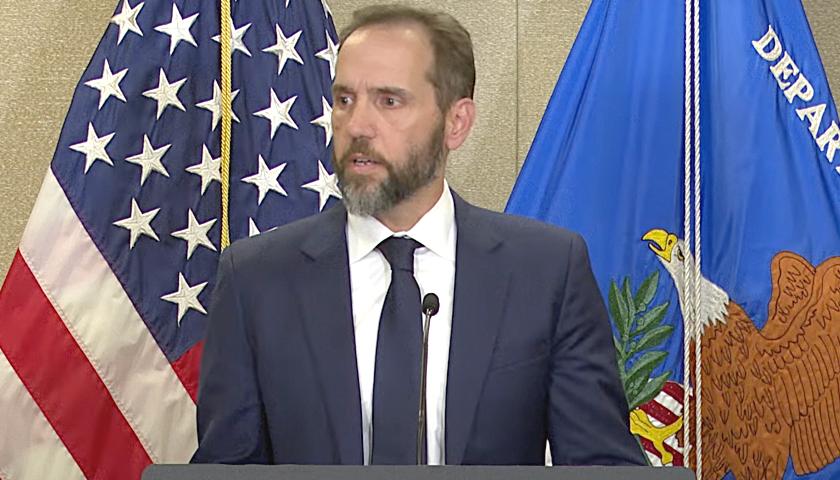If you thought that the proposed Equal Rights Amendment (ERA) to the United States Constitution offered by the 92nd Congress to the state legislatures for ratification back in 1972 was just a distant memory–and a thing completely of the past–think again.
Its cheerleaders during the 1970s endeavored to sell ERA as nothing more than guaranteeing equal legal rights for women and men. And, certainly, that had a nice ring to it. The U.S. Senate shouted its approval of ERA on March 22, 1972, with 84 yeas, 8 nays and 7 not voting. Previously, on October 21, 1971, the U.S. House of Representatives roared its blessing with 354 yeas, 24 nays and 51 not voting. And, with that, ERA was placed before the nation’s state legislatures for their consideration, pursuant to the well-established procedures found in the U.S. Constitution’s Article V.
In tendering ERA to the states, the 92nd Congress had imposed a customary deadline of seven years–or until March 22, 1979–for America’s state lawmakers to fully ratify ERA in order for the measure to officially become part of the U.S. Constitution.
With 50 states in the Union in 1972–and still 50 in it today–a proposed federal constitutional amendment must be formally ratified in 38 (or three-fourths) of the states in order to be added to the nation’s highest legal document.
Right out-of-the-gate, ERA enjoyed a robust showing among the country’s state lawmakers. By the end of 1972 alone, the legislatures of 22 states had thundered their endorsement, including that of the 87th Tennessee General Assembly, which promptly adopted House Joint Resolution No. 371 as an expeditious show-of-support.

During 1973, ERA commanded ratifications by lawmakers in eight additional states so that ERA backers counted 30 of the required 38 states as being officially onboard with the measure. In the estimation of most observers, ERA appeared well on its way to becoming the federal Constitution’s 27th Amendment–and presumably comfortably within its March 22, 1979, ratification deadline.
But as early on as that year of 1973, things were slowing down considerably for the proposal and cracks were becoming visible. After all, it was during 1973, that Nebraska lawmakers–upon deeper reflection–rescinded their 1972 ratification of ERA, the first such fissure in an otherwise seemingly invincible juggernaut.
Next, in 1974, Tennessee legislators likewise experienced “buyer’s remorse” and, in the form of the 88th General Assembly’s Senate Joint Resolution No. 29, rescinded the self-described hasty 1972 ERA adoption by the previous 87th General Assembly.
Furthermore, the year 1974 brought the pace of state ratifications to a mere trickle with only Maine, Montana and Ohio lawmakers ratifying ERA. From there, the ERA drought only worsened.
In 1975, North Dakota was the lone state to give its assent. And the Bicentennial year of 1976 afforded ERA advocates nothing more to celebrate than the nation’s 200th birthday.
Indiana legislators furnished ERA’s sole ratification in 1977, while Idaho lawmakers–that same year–joined their Nebraska and Tennessee counter-parts with the nation’s third rescission of a previous ERA adoption.
The year 1978 provided zero ERA ratifications and fetched yet a fourth rescission–this time from legislators in Kentucky.
ERA promoters insisted that state legislatures have no ability to rescind–at any point in the process–a prior ratification granted to a federal constitutional amendment. Hence, according to persons championing ERA, the measure stood at 35 of the needed 38 ratifications with Indiana’s 1977 approval.
ERA detractors counter-claimed that–taking the four rescissions into account–the proposition actually enjoyed only 31 ratifications by the end of 1978.
Those generally opposing ERA maintained–among other things–that, if ratified, ERA would require women to be drafted into the military; that separate public restrooms for men and women would end and that all such facilities would become unisex and shared; that ERA would pave the way for same-sex marriage; and that taxpayers would end up footing the bill for low-income women to have “medically-necessary” or even elective abortions. Whether these assertions, and others, were successful in dissuading lawmakers in unratified states to eschew ERA cannot be proven conclusively, but it is clear that ERA’s momentum had come to a crawl after 1973 and had sputtered to an absolute stand-still by 1978.
It comes as no surprise that ERA crusaders found themselves in utter panic by this point. That consternation was not withheld from members of Congress. During 1977 and 1978, ERA proponents pleaded with the U.S. House of Representatives and beseeched the U.S. Senate to do something completely without precedent–allow the state legislatures more time to consider, debate, and cast votes upon, the ERA.
As an aside, it was in the year 1917 that Congress first began the practice of placing ratification deadlines upon state legislative consideration of proposed federal constitutional amendments. Any such measure presented to the states prior to 1917 had no deadline at all.
During the post-1917 era, however, Congress–with only two exceptions–chose to set a deadline, and deemed a time frame of seven years for state lawmakers to consider, and favorably act upon, a proposed constitutional amendment to be appropriate.
The U.S. Supreme Court, in the 1921 case of Dillon v. Gloss, agreed that Congress possessed such authority to fix a ratification deadline and the Justices found nothing unreasonable about Congress’ choice of seven years for the state legislatures to weigh the merits of, and cast votes upon, a proposed constitutional amendment.
But while Congress had been proffering proposed amendments–accompanied by seven-year ratification deadlines–to the states literally for decades, never before had the question arisen whether to extend that window beyond the routine seven years that had been initially allotted at the time of Congressional submission of each individual proposal to the states.
If Congress actually could lengthen a previously agreed-upon deadline, what vote in the U.S. Senate and in the U.S. House of Representatives would be required? Would a simple majority suffice? Or would it–as with offering the measure to the states in the first place–need a two-thirds supermajority?
On October 6, 1978, the 95th Congress approved an alleged extension of ERA to June 30, 1982. Because it garnered only a simple majority in both Congressional chambers–significantly less than a two-thirds vote in either body–the joint resolution establishing the purported new ERA ratification deadline of June 30, 1982, was placed before then-President Jimmy Carter for signature, as a safety precaution.
Carter proceeded to sign it on October 20, 1978 although noting–on strictly procedural grounds–the irregularity of any President signing a document that was directly related to the status of a proposed federal constitutional amendment. In the 1798 case of Hollingsworth v. Virginia, the Supreme Court settled, very early in American history, any doubt that the President plays absolutely no formal role in the process by which the U.S. Constitution is amended.
Reacting directly to the 95th Congress’ action, South Dakota legislators, on March 1, 1979–while not going quite so far as to rescind that state’s 1973 ratification of ERA–gave final approval to a joint resolution declaring its 1973 ratification to be valid only through the original deadline of March 22, 1979, and not a day beyond March 22, 1979.
A lawsuit was filed in response to the supposed ratification deadline extension. In the 1981 case of Idaho v. Freeman, a federal district court ruled that the much-disputed extension to June 30, 1982 was improper and that ERA ceased to be pending business before the country’s state legislatures back in March of 1979–as the 92nd Congress had first intended. The lower court further found that state lawmakers indeed may rescind a previous ratification of a proposed federal constitutional amendment as long as such rescission occurs before the necessary number of states have favorably acted to complete the specific proposed amendment’s ratification process.
On January 25, 1982, the Supreme Court stayed the lower court’s rulings, thus signaling to lawmakers in unratified states that they may still consider and act upon ERA during their spring 1982 legislative sessions. But when June 30, 1982 arrived, Indiana’s 1977 ERA ratification remained the last approval.
When the Supreme Court reconvened at the conclusion of its summer sabbatical, the Justices declared, on October 4, 1982, the entire controversies–of the deadline extension and of the question as to whether states may rescind–to be moot given that no state ratifications materialized between the original ratification deadline of March 22, 1979, and the putative extended deadline of June 30, 1982. Thus, nothing instructive emerged from the highest court in the land out of what had been a years-long raging national debate.
In the immediate aftermath of June 30, 1982, it was generally believed that the 1972 ERA had officially failed of ratification.
A decade later, in 1992, a very different proposal ended up actually becoming the Constitution’s 27th Amendment. It restricts the timing of adjustments in the compensation of members of Congress.
In 1997, the William & Mary Journal of Women and the Law published “The Equal Rights Amendment: Why the ERA Remains Legally Viable and Properly Before the States.” In that article, co-authors Allison L. Held, Sheryl L. Herndon and Danielle M. Stager contended that the March 22, 1979 and June 30, 1982 ratification deadlines could be either again revised, completely lifted, or left unchanged and callously ignored by a sympathetic future Congress willing to turn-a-blind-eye to the procedural abnormalities of a late-ratified ERA if the legislatures of just three more states were to belatedly confer their approbation upon the measure. This theory is referred to, by some of its adherents, as the “three-state strategy”.
In the 1939 case of Coleman v. Miller, the Supreme Court recognized Congress’ ability to overlook unconventional occurrences among the states and to proclaim as valid an atypically-ratified federal constitutional amendment. Therefore, it is critical that Congress be very officially cognizant of each state’s stance on a given proposed federal constitutional amendment–including any action to revoke and nullify an antecedent approval.
It was some 20 years after the publication of the strategy outlined in the William & Mary Journal of Women and Law that a state’s legislature acted upon the theory. The Nevada Legislature, on March 22, 2017–45 years to the day that the 92nd Congress originally submitted it to the state legislatures–belatedly ratified the ERA. This, of course, coming four decades after Indiana’s 1977 ratification.
Then, on May 30, 2018, the Illinois General Assembly completed its own behindhand ERA ratification.
Basking in elation, ERA supporters–still choosing to rebuff the 1970s rescissions of Nebraska, Tennessee, Idaho and Kentucky, and the 1979 “sunsetting” by South Dakota, as well as newly asserting that both the 1979 and 1982 deadlines can simply be disregarded–trumpeted as fact that ERA now stands, they claim, at 37 of the essential 38 ratifications for the measure to be incorporated into the Constitution as that document’s 28th Amendment. Surprisingly, media coverage has been rather sparse.
If the legislature of one more state were to late-ratify the 1972 ERA, what would be the result? Does the 92nd Congress’ ERA truly hold 37 of the mandatory 38 state legislative approvals? Can both the 1979 and 1982 deadlines be cavalierly dismissed?
Whether or not the 46-year-old ERA has genuinely sprung back to life, it is important–given recent events in Nevada and Illinois–that each administrative “i” be dotted and that every clerical “t” be crossed.
This author, known for attention to detail, thoroughly scoured the Congressional Record, the Journal of the United States Senate, and the Journal of the United States House of Representatives, covering years 1973 to 1982, in search of the rescinding resolutions passed by Nebraska, Tennessee, Idaho and Kentucky lawmakers and the “sunset” resolution approved by the South Dakota Legislature.
Present and accounted for are the Nebraska, Idaho, Kentucky and South Dakota resolutions–dutifully transmitted to and formally received by–both houses of Congress during the same exact 1970s years that lawmakers in those four states approved them.
Not so, however, with Tennessee’s 1974 Senate Joint Resolution No. 29 by which the 88th Tennessee General Assembly acted to repeal and cancel the 87th General Assembly’s 1972 ERA ratification. Although S.J.R. No. 29 clearly directed then-Tennessee Secretary of State, Joe C. Carr (now deceased), to forward official copies of it to the U.S. Senate and to the U.S. House of Representatives, neither chamber ever received S.J.R. No. 29.
Indeed, to this day in 2018, no trace of Tennessee’s 1974 S.J.R. No. 29 is to be found anywhere on the pages of the Congressional Record or of the journal of either body of Congress–ergo, it is the only ERA rescission resolution failing to make its way to either house of Congress. Once either chamber officially receives a resolution of this type from a state legislature, that state resolution is formally noted in the Congressional Record as well as in that particular body’s journal and it is then ritually referred to at least one committee of that house. Under standard practice, the U.S. Senate will publish the full and complete verbatim text of a state legislative resolution in its portion of the Congressional Record, and within its journal, while the U.S. House of Representatives will merely summarize the contents of such a resolution in its own part of the Record and within its own journal.
None of those things have yet happened with Tennessee’s 1974 S.J.R. No. 29 ERA rescission. Officially, for 44 years, Congress has had no tangible knowledge of Tennessee’s 1974 rescission–and yet the Supreme Court conceded in 1939 that Congress, rather than the federal courts, is the ultimate arbiter of whether anomalies in a proposed constitutional amendment’s movement through the states are enough to derail the success of such a proposed amendment. Whatever information–if any at all–that Congress might have about Tennessee’s rescission can only be described as informal heresay.
Shouldn’t Congress be officially notified of Tennessee’s 1974 S.J.R. No. 29?
If it is not “too late” for Nevada and Illinois lawmakers to purportedly “ratify” the 1972 Equal Rights Amendment, in 2017 and 2018, and to send their attested paperwork to Capitol Hill for inclusion in the Congressional Record and journals of the U.S. House and Senate, then it is likewise not “too late” for the current Tennessee Secretary of State, Tre Hargett, to attend to what his late predecessor, Mr. Carr, neglected to do 44 years ago–that is, separately transmit now, to Vice-President Mike Pence and to House Speaker Paul Ryan, individual duly-certified copies of Tennessee 1974 S.J.R. No. 29 so that the resolution may be formally entered in the Congressional Record, and the respective bodies’ journals, and be officially referred to committees in both chambers.
This author went to the trouble of writing a detailed letter, with enclosures, to current Secretary of State Hargett, which was sent–via certified mail–on July 16, 2018. According to the green return receipt card, the envelope was received by the Tennessee Secretary of State’s office on July 24, 2018. That letter asked Secretary Hargett to convey properly-authenticated copies of 1974 S.J.R. No. 29 to both houses of Congress as described above. Will Secretary Hargett, and his staff, actually do what is being requested of them? Or will he, and his employees, casually ignore the issue by simply doing absolutely nothing at all? Thus far, no reply has been received to the July 16th letter.
Keep in mind that it is not unheard of for a state legislative resolution to find its way to one, or both, chambers of Congress rather tardily. In 1976, for example, Pennsylvania lawmakers approved House Resolution No. 236, which was officially received by the U.S. House of Representatives some 40 years later in 2016 and was formally referred to the U.S. House’s Committee on the Judiciary upon its belated receipt in 2016.
[pdf-embedder url=”https://tennesseestar.com/wp-content/uploads/2018/08/TN-Sec-of-State-Hargett-Ltr-Certified-Mail-July-16-2018.pdf” title=”TN Sec of State Hargett Ltr Certified Mail (July 16 2018)”]






[…] contained a customary deadline of seven years, which expired with only 35 of the required 38 states […]
[…] contained a customary deadline of seven years, which expired with only 35 of the required 38 states […]
[…] contained a customary deadline of seven years, which expired with only 35 of the required 38 states […]
Full constitutional equality for men and women is a worthy goal. Ratification of the Equal Rights Amendment is a necessary clarification of the 14th Amendment’s equal protection clause. A person’s rights, responsibilities, and benefits should not depend upon their sex.
Many who opposed the 1972 Equal Rights Amendment did so on the basis of its wording:
“SECTION 1. Equality of rights under the law shall not be denied or abridged by the United States or by any State on account of sex.
“SEC. 2. The Congress shall have the power to enforce, by appropriate legislation, the provisions of this article.
“SEC. 3. This amendment shall take effect two years after the date of its ratification.”
Opponents have expressed concerns about society’s ever-evolving definition of the word “sex” and fear how federal judges would construe that word in 2018 versus how they might have construed it during the 1970s.
Opponents have likewise expressed concern about the massive transfer of power from state government over to the federal government by ERA’s Section 2. Would Section 2 divest the states of the ability to legislate in response to their own unique circumstances?
Some ERA opponents have suggested returning to the original wording for the ERA: “Women and men shall have equal legal rights throughout the United States and any place subject to the jurisdiction of the United States.” Some ERA opponents find that original wording far less cause for concern than the verbiage from the 1972 version.
Also, do ratification deadlines simply mean nothing at all?